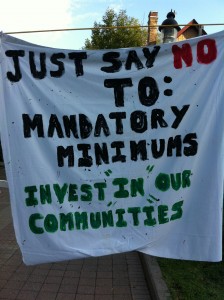by Natasha Brien
On August 10, 1974, a prisoner by the name of Eddie Nalon died after bleeding to death in the segregation unit of Millhaven Maximum Security Prison in Kingston, Ontario. Systemic issues of unjust prison policy, and abuse of power, were deeply entangled in the cause of his death.
 Mr. Nalon initially wanted a transfer to another unit. After officially requesting a transfer, he was instead placed in segregation, and eventually solitary confinement. Mr. Nalon made a written request to be placed back into general population, which the board approved; however, this decision was not conveyed to Mr. Nalon.
Mr. Nalon initially wanted a transfer to another unit. After officially requesting a transfer, he was instead placed in segregation, and eventually solitary confinement. Mr. Nalon made a written request to be placed back into general population, which the board approved; however, this decision was not conveyed to Mr. Nalon.
When August 9, 1974 arrived – the ninth of the month being the standard transfer date to be released into general population – and he wasn’t moved, Mr. Nalon must have assumed he would be left in segregation longer, and that his request was denied. The following day, Mr. Nalon committed suicide. It was later discovered that the emergency button in his cell was non-functional, thus any attempts to call for help, would have likely gone unheard by prison guards.
Every year since his death, August 10 is the day when Mr. Nalon’s life is commemorated; and has eventually this day coming to be recognized as Prisoner’s Justice Day (PJD). On this day, inmates and their allies in Canada and throughout some U.S. states, protest the mistreatment of men and women behind bars. Supporters of PJD express abhorrence for inhumane prison conditions, as well as mourn the deaths of countless people who have lost their lives while in custody or through conflict with the law. Prisoners remain in their cells for the day, fasting, and refusing to work, while non-incarcerated people hold gatherings in many cities across Canada and the U.S.
The theme of Toronto’s 2012 PJD, was ‘Women in Prison’, which took place at the Church of the Holy Trinity behind the Eaton Centre. Brampton also held a PJD that took place in St. James the Apostle Church with the theme being ‘We Will Be There for You’. At these two community gatherings, loved ones of inmates, ex-prisoners, activists, and concerned organizations partook in fasts, presentations, songs, poetry, viewing documentaries, and readings of stories from former inmates.
What really stood out, was the common theme that most imprisoned people come from various communities struggling to rise above oppression – poverty, systemic racism, childhood abuse, spirit injuries via colonialism, gender injustices etc. – only to enter into further institutional forms of violence via incarceration. Aside from extreme lateral violence amongst inmates, correctional institutions have also been guilty of violating the Correctional Service of Canada’s (CSC) code of conduct.
A well-documented example of prison violence is evident in the case of Ashley Smith – a woman who died in solitary confinement at the Grand Valley Institution for Women in October 2007. Some may say that Ms. Smith killed herself: the immediate cause of her death came through self-asphyxiation, as guards watched the incident take place. But Ms. Smith had been transferred between institutions seventeen times already within the year, having been pepper sprayed, tasered, subjected to full body restraints, involuntarily injected with anti-psychotic medications, and spending most of her last three years in “the hole” (solitary confinement). It’s hard to imagine how anyone could survive such conditions.
 During the evening of the 2012 PJD in Toronto, a vigil was held outside of the Don Jail to protest the experiences people like Ms. Smith endure. People took to the microphone to share personal experiences and statistics surrounding these shameful conditions, and the dangers involved in expanding prisons, as well as creating harsher criminal laws. The crowd yelled in unison messages of support for inmates in hope that men currently in the Don Jail – and ghosts of men and women who have passed – would know they are not alone. The vigil concluded with a candle lighting ceremony, honouring our fallen brothers and sisters, and those still in the prison struggle, while putting out a call for the implementation of restorative justice everywhere.
During the evening of the 2012 PJD in Toronto, a vigil was held outside of the Don Jail to protest the experiences people like Ms. Smith endure. People took to the microphone to share personal experiences and statistics surrounding these shameful conditions, and the dangers involved in expanding prisons, as well as creating harsher criminal laws. The crowd yelled in unison messages of support for inmates in hope that men currently in the Don Jail – and ghosts of men and women who have passed – would know they are not alone. The vigil concluded with a candle lighting ceremony, honouring our fallen brothers and sisters, and those still in the prison struggle, while putting out a call for the implementation of restorative justice everywhere.
Comments
